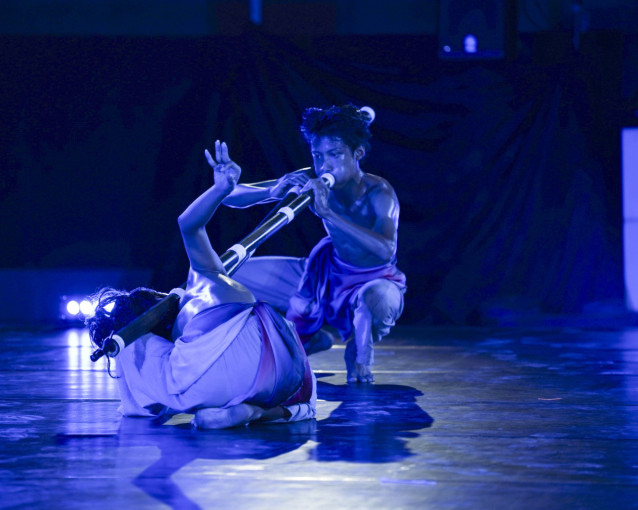
The event “The Life of Butoh,” hosted by UGM Innovation and Creativity Hub (GIK UGM) from Sept. 4 to 5, 2024, successfully presented an Indonesian-Japanese culture art stage.
This performance resulted from a collaboration between Butoh artists, represented by six performers each from Indonesia and Japan.
Being performed in Yogyakarta over 15 years ago, Butoh still attracts many enthusiasts. Originating in Japan, this art has gained recognition in various countries, including Indonesia.
Its inception was a response to Western culture’s dominance following Japan’s defeat in the Greater East Asia War. Kazuo Ohno and Tatsumi Hijikata founded Butoh as a form of resistance against that culture.
Butoh was then established as an avant-garde art form characterized by provocative and unconventional performances.
The Butoh performances at GIK UGM featured renowned artists such as Jun Amanto, Mutsumi-Neiro, Rina Takahashi, Minoru Hideshima, Rianto, Fitri Setyaningsih, Broto Wijayanto, Anter Asmorotedjo, Endy Baroque, and Mugiyono Kasido.
Each performance was beautifully packaged, intense, and meaningful, reflecting on the human experience. Butoh also evolves alongside societal changes that alter human lifestyles.
Chief Program Officer at GIK UGM, Garin Nugroho, explained the modern interpretation of Butoh’s movement.
“The body has become a significant element in modern lifestyles, often displayed as an object both in daily life and on social media. The ideal body frequently loses touch with reality and deep self-knowledge,” he stated.
One of the dances, “Hormon 46++,” by Fitri Setyaningsih, portrays the life stories of women aged 46 and above. At this stage, women’s bodies begin to experience a slowdown in cycles, even entering the phase of reproductive cessation.
This feeling is expressed through the symbolic imagery of a volcano that holds hot lava beneath the earth, gradually rising to the surface and becoming solid lava.
“Changes are inevitable; every woman will experience it. But there’s no need to fear; it’s a part of life that we must accept,” Setyaningsih explained.
Another unique work was presented by Mugiyono Kasido, an Indonesian artist who successfully explored the traditional blowing gong from Banyumas.
Through “Bayu Akasa,” or “Wind of Life,” Mugiyono showcased layers of sound from the blowing gong without melody. The fusion of this traditional musical instrument produced a new and captivating performance, interpreted as a continuous and evolving life journey.
As is characteristic of Butoh art, there is always an allure in the challenging and unique attractions of the artists. Neiro and Mutsumi Yamamoto, two Japanese artists, performed their work nearly unclothed.
The combination of classical and modern Japanese music in their dance created a uniquely new atmosphere. Both explored the meaning of creativity and boundless thought.
“Limits are an illusion. We don’t want to define our performance, but how the audience interprets it is much more important,” Neiro concluded.
In addition to these three performances, there were several other intriguing displays worth exploring, such as “Kaguya,” which tells the story of a man’s love for the Moon Princess, and the Lengger dance as a form of gender-crossing dance.
Although provocative in tone, Butoh encompasses a much broader range of inspirations. Artists can explore various life phenomena, including bodily metamorphosis, ideologies, and the idealism of the times.
Butoh, in the modern era, delves deeper into the essence of the body itself. This interpretation arises from the massive developments of our time, which give rise to digital phenomena.
Humanity has become accustomed to living in virtual spaces that gradually distance individuals from reality. Butoh’s performance encapsulates this meaning through various free and expressive body movements. Interestingly, the two cultures collaborated in the performance, creating a new harmony.
Aji Wartono, Chief of Program at GIK UGM, emphasized the importance of showcasing Butoh art at GIK UGM.
“Knowledge drives progress. Studying and observing cultural arts from outside our own culture is crucial for broadening our horizons and developing our own arts and culture,” he explained.
Author: Tasya
Editor: Gusti Grehenson
Post-editor: Lintang

